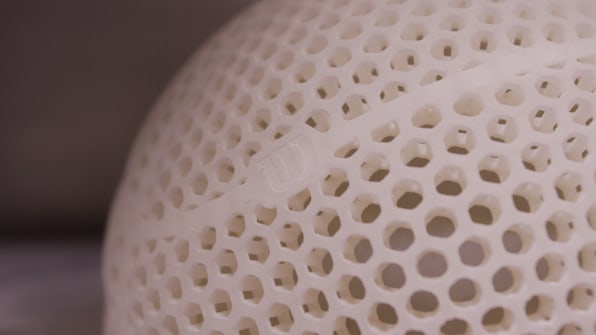- | 8:00 am
Wilson’s 3D-printed basketball never needs to be inflated
Wilson’s ‘Airless’ basketball of the future trades an interior bladder for a 3D-printed lattice, yet it bounces just like a traditional ball.

Nadine Lippa, innovation manager at Wilson Sporting Goods, wasn’t joking when she says her boss tasked her to “reinvent the basketball.” And her 3D Airless Prototype Basketball does feel like something from the future.
Aside from the size and the gripping lines that cut through the surface of a basketball, the Airless doesn’t look like a typical ball. For starters, you can see through it. Wilson’s Airless Prototype doesn’t have any bladder inside and thus no way to contain the pressurized air that makes a ball bounce. Instead, it’s comprised of a lattice made of hundreds of tiny hexagonal holes. This means the ball doesn’t need to be inflated and will never go flat. And yet, it bounces like a real basketball.
Technology advances have long spurred sports gear redesigns. Tennis, for example, went from handmade solid wood rackets with strings made of animal intestines to robot-built ultralight carbon- fiber structures.
Sometimes, these innovations are designed to solve game-time problems, like rugby balls that contain sensors to stop forward passes. Other times, the invention aims to fix undesirable side effects, like Renewaball, a company that invented a technology to recycle discarded tennis balls into new tennis balls (astonishing fact of the day: there are 325 million tennis balls produced every year, which result in 22,000 tons of not-biodegradable waste).

Soccer balls—the most popular ball in the world after, say, meatballs—evolved through decades of geometric and material changes, going from heavy, hand-stitched leather to two foam layers wrapped inside polyurethane. Two years ago, Japanese design house Nendo created a soccer ball that doesn’t need to be inflated. Unlike the Airless Prototype, Nendo’s ball is assembled by the players using panels and internal segments that result in a sphere that acts pretty much like an inflatable ball.

HOW IT’S MADE
Wilson’s new basketball doesn’t require assembly because it’s manufactured using 3D printing. During a presentation at the NBA All-Star Weekend, Wilson innovation manager Lippa said the engineering team faced a two-pronged design challenge: First, they needed to figure out the correct geometry for the 3D lattice, and then they needed to find a material that would allow the ball to absorb the right amount of kinetic energy so it could rebound like a traditional ball. “The materials with high-energy return were often not durable enough for our application. The adequate method-mechanical-material combination that bounced like a basketball was elusive to the team, and there were so many additive technologies to sift through and understand,” she explained.
The challenge was so hard that, according to Lippa, it took several years for the team at Wilson Labs in Chicago to create a prototype that ticked all the boxes. In the end, it worked perfectly. At the event, Houston Rockets forward KJ Martin showcased the Airless Prototype during the Slam Dunk Contest, and said that, even while he thought the ball “looked crazy,” it bounced and felt just like a normal basketball.
Don’t expect to see the Airless Prototype Basketball at your nearest sporting goods store anytime soon, though. Right now, this ball is a one-of-a-kind prototype. As Lippa said in an interview with Forbes, there will be more versions coming in the future: “We also want the next iteration to be informed by fan and athlete insights, so we are excited to see how the dunk contest is received.”
Okay, so we’ll have to wait, but it’s certainly in Wilson’s best interest to make the Airless basketball happen and get it to market soon. I showed the video of the Airless basketball to my 6-year-old son, and he already wants one.





































